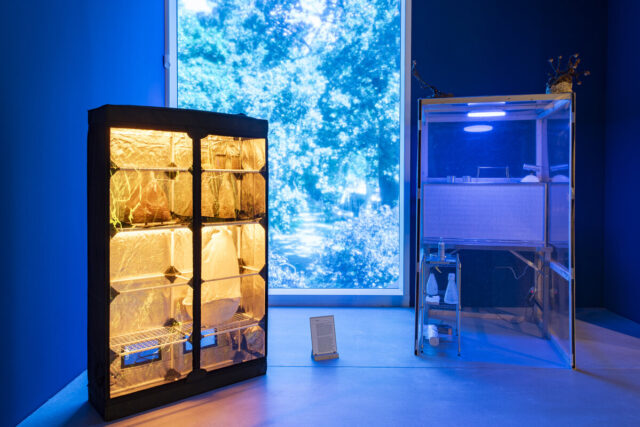Attention is very important in the house of disputes in Berlin-Neukuln. This is manifested in the large rooms of the house, which were completed only two years ago. Inside, you look at the turbulent movement of Hermannstrass, feeling at the same time around the envelope of the building, built in accordance with the criteria of stability – many wood and stones from demolition houses – and focuses on what was extracted inside.
In the case of the new group exhibition “Welto and The Sacred Bush” these are primarily objects and organisms from the world of the Caribbean island. Annali Davis, an artist from Barbados, brought many leaves from Martinic to Berlin and ordered her as a geometric explosion on the wall. “This is a kind of mandala. If you have stress, you can just come here, sit down and look at the leaves. It will calm you down. Each sheet is so individual, has its own shape. And yes, you can see it as an explosion, but perhaps as well as an idea of the world or as a sign of the penetration of everything in the world that surrounds us, ”says Davis. Most of the leaves gathered him in the Portivi Garden initiative in the north of Martinic. Having prepared for the Berlin exhibition, she remained there as part of the residence.
The topic is the Caribbean garden. Davis emphasizes that he goes far to create beds and aesthetically attractive plants of plants: “This is a practice that is feeding on the history of slavery and resistance to slavery.”
Initially, these were small areas that enslaved people used to grow fruits and vegetables for their own use, as well as medicinal herbs and plants, which were attributed to spiritual effective forces. “In their diversity, they also represented an alternative to monocultures of plantations, which Money cultures Like sugarcane or bananas, ”says Davis. Since people in the gardens take care of plants together, but also exchanged their daily problems, they were increasingly located, where the will turned into collective resistance.
Communication with the Earth
The initiative of Permactivia deliberately occupies this practice. “This is a mixture of permaculture and activity. We get organic waste from the surrounding cities and make compost. We use it in our garden, ”says Marseille Jean-Batist, an artist and coordinator from Putmactivie. When he was asked what plants grew up there, he should smile. “We are often asked what we grow there. But for me this is more about the connection with the land that grows there, what types of communication are established, ”he says about the basin.
Two video installations of the French director Florence Lazar are included in social practices between people, plants and land. In “125 hectares”, she has documented the initiative of small farmers in Martinik, which since 1983 occupied 125 hectares of land and creates an alternative to ordinary monocultures with diversified crop rotation. Nevertheless, they are also threatened with rising prices for soil and soil poisoning on pesticide chlorine. Lazar works in discussions with drug experts and shrubs in conversations with drug experts and medicines.
To date, the noticeable consequences of the colonization of the Caribbean basin are also obvious in the context of the exhibition in other ways. For example, Davis, based in Barbados, only came into contact with Permactivia through the Berlin project. And since road ties between the islands are extremely bad, it took more time to travel from Barbados to Martinics to lead to direct flights from the islands to Europe.









